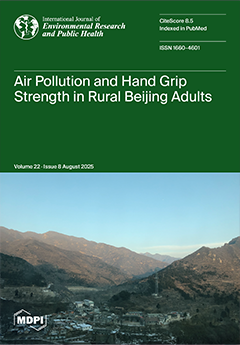Background: Outdoor and household PM
2.5 are established risk factors for chronic disease and early mortality. In China, high levels of outdoor PM
2.5 and solid fuel use for cooking and heating, especially in winter, pose large health risks to the country’s aging population. Hand grip strength is a validated biomarker of functional aging and strong predictor of disability and mortality in older adults. We investigated the effects of wintertime household and outdoor PM
2.5 on maximum grip strength in a rural cohort in Beijing.
Methods: We analyzed data from 877 adults (mean age: 62 y) residing in 50 rural villages over three winter seasons (2018–2019, 2019–2020, and 2021–2022). Outdoor PM
2.5 was continuously measured in all villages, and household (indoor) PM
2.5 was monitored for at least two months in a randomly selected ~30% subsample of homes. Missing data were handled using multiple imputation. We applied multivariable mixed effects regression models to estimate within- and between-individual effects of PM
2.5 on grip strength, adjusting for demographic, behavioral, and health-related covariates.
Results: Wintertime household and outdoor PM
2.5 concentrations ranged from 3 to 431 μg/m
3 (mean = 80 μg/m
3) and 8 to 100 μg/m
3 (mean = 49 μg/m
3), respectively. The effect of a 10 μg/m
3 within-individual increase in household and outdoor PM
2.5 on maximum grip strength was 0.06 kg (95%CI: −0.01, 0.12 kg) and 1.51 kg (95%CI: 1.35, 1.68 kg), respectively. The household PM
2.5 effect attenuated after adjusting for outdoor PM
2.5, while outdoor PM
2.5 effects remained robust across sensitivity analyses. We found little evidence of between-individual effects.
Conclusions: We did not find strong evidence of an adverse effect of household PM
2.5 on grip strength. The unexpected positive effects of outdoor PM
2.5 on grip strength may reflect transient physiological changes following short-term exposure. However, these findings should not be interpreted as evidence of protective effects of air pollution on aging. Rather, they highlight the complexity of air pollution’s health impacts and the value of longitudinal data in capturing time-sensitive effects. Further research is needed to better understand these patterns and their implications in high-exposure settings.
Full article





